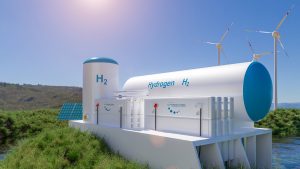Experts from Tamarindo’s Power-to-X Leadership Council explore how green hydrogen developers can get early-stage projects off the ground and secure funding.
Following the Russian invasion on Ukraine which started in February 2022, governments across Europe pivoted to devise new energy security plans to compensate for the loss of Russian imports. Previous plans to use hydrogen – especially green hydrogen – as an energy vector, which in some cases may have been modest and long-term, had to be accelerated and the scope of ambition increased. For instance, in April 2022, the UK doubled its targets for green hydrogen production, aiming for approximately 5GW by 2030.
While this signals the intent to usher green hydrogen into the clean energy mix in a meaningful way, this is merely the first, and easiest, step in the journey of incorporating it into future energy plans. As developers have learned in the past year, actually getting projects up and running is not so straightforward. It is not a lack of appetite or even the difficulty of producing green hydrogen that impedes developers most. Instead, it is the endpoint of the process that is the stumbling block.
The key priority for developers must be to structure supply and eliminate risks where possible.
Starting at the end
Green hydrogen is not an industry in which developers can focus solely on generating clean energy in the knowledge that there will be plenty of energy off-takers who will purchase the product.
Whereas traditional renewable developers will have a clear plan for where their product will eventually go, in the case of green hydrogen – since the market for it is still developing – this journey is much less apparent. It is true that hydrogen is already being used, but this is mostly grey hydrogen – a much cheaper product in today’s market.
As a result, it is paramount to project success that green hydrogen developers have thoroughly considered who will pick up their output. If there is no prior plan for where the energy is destined to go, it threatens to jeopardise green hydrogen projects from the outset.
This is because many off-takers are daunted by the prospect of the upfront capital cost, as well as the supply chain risks that they foresee in new technology. While finding an end user for their supply is one of the most critical tasks for hydrogen developers, it is also one of the biggest challenges the industry is facing.
This challenge does not spring from a lack of buying intent. Nonetheless, developers have found that customer enthusiasm is dashed for the most part by the unknowns in the nascent hydrogen market. In particular, some companies have said:
- They do not know how they can make best use of hydrogen;
- They do not have the requisite information to inform how much they would be willing to pay for it;
- They anticipate steep costs involved in transitioning away from proven technology; and
- They are waiting for others to lead the way before they feel comfortable following suit.
As green hydrogen becomes more of a known quantity, you would expect there to be more synergy in future between developers and off-takers. However, for now, developers need to demonstrate to off-takers that these risks have been considered, and build a rapport where understanding of the risks is mutually shared.
As such, the best place for developers to start with their projects is at the end, asking themselves such questions as: Who will be the off-taker of this hydrogen? Over what period of time will they take the hydrogen? What price will be agreed? This might seem self-evident but identifying a suitable off-taker is foundational in getting early projects off the ground.

Hydrogen developers need to devise storage solutions to guarantee supply
Green hydrogen: Supply risks
One of the key reasons why end users need to be built into the project plan is because the end user informs the supply strategy. Indeed, the strategy for production will differ according to who is lined up to purchase the hydrogen. Fundamentally, project construction depends on a renewable energy source, a sustainable water source, transportation solutions, and storage solutions.
A developer might locate a renewable energy source to supply the electricity needed for their electrolysis, but if the site is far away from the customer and there is no feasible means of transporting the product, then the project becomes unworkable. Equally, a developer might find a site that appears to have excellent connections to the intended end user, through a pipeline or strong transport links. But if there is no renewable energy source available and the developer has not budgeted for building one then, again, the chances of the project gaining traction are slim.
Equally, developers need to devise storage solutions to guarantee supply. In its current phase, on-site storage is the preferred method used in the industry. That may be fine for now, but there is awareness that, if the industry is to scale, it will be necessary to find alternative ways of storing hydrogen that are reliable and cost effective. In this niche, there are opportunities for specialist third parties to enter the supply chain to manage storage solutions.
Ultimately, one of the benefits of developers and end users working collaboratively from a project’s inception is the increased opportunity of finding innovative solutions to risks, such as storage through a shared network and understanding of each other’s operations.
As an emerging technology, the permitting of green hydrogen projects is a protracted process, so developers will be aware that, in more extreme cases, they may have to wait up to two and a half years before getting the approval to proceed. This only serves to emphasise how important it is for developers to involve authorities and customers from the start of the process so that impracticalities can be identified early on along with potential solutions. A worst-case-scenario would be that a developer has waited two years for permitting only to realise that the project design is not fit for purpose.
Green hydrogen: Supply strategies
As developers look to reassure investors that these risks have been thoroughly considered, it is essential that they devise an initial short-term strategy to show the potential benefits of green hydrogen and to work through anticipated teething issues. Though there is only a patchwork of legal frameworks in place, developers and off-takers can take inspiration from the trading of biofuels, as well as the conventional arrangements for hydrogen and gas, to provide a sound starting place. There are a few strategies that can be deployed to this end.
One option is to supply to off-takers who already consume grey hydrogen. These off-takers are likely to already have a means of taking receipt of hydrogen and of storing it, which takes some additional pressure off developers. Since the off-taker will not be fully reliant on green hydrogen, due to its other intake of hydrogen, this arrangement also gives developers time to monitor and perfect their production. Moreover, this experience allows developers to learn from other molecule-selling markets, like grey hydrogen, through direct experience.
Another path for developers to consider is to supply to off-takers who will take gas blended with hydrogen. As with the previous option, the off-taker does not have to invest in new infrastructure to receive the green hydrogen and, if any problem should occur in the supply, they can fall back on 100% natural gas. This would be another relatively risk-free environment for developers to hone their practice and demonstrate the value of hydrogen.
These two options give viable routes for developers to go about building confidence in green hydrogen to secure more long-term projects in the future. A way of fast-tracking this process, however, might be through constructing projects as close to the off-taker as possible. Targeting sites near industrial clusters to supply hydrogen will reduce transportation risks and costs, while also exposing developers to the responsibility of being a customer’s sole energy provider. As such, there is more long-term strategy in this approach.
Alternatively, producers may look into becoming their own off-takers. Though not many developers are likely to have the capacity to both produce and off-take, there are examples of some green hydrogen developers taking ownership of both the supply and the end-use by acquiring and powering bus fleets. This introduces a host of different challenges in the form of project bankability and attracting a different type of investment. But as the world pushes for cleaner power, these are opportunities that can be seized.
Navigating evolving regulatory and legal frameworks
One of the difficulties for developers embarking on projects that have very few precedents is that there is a lack of examples by which to be guided. This is exacerbated by indecision about whether to blend hydrogen into existing gas pipelines. In the UK, no decision has been reached on this and there is no forthcoming indication of when blending might be allowed if, indeed, it is to be allowed. To be clear, green hydrogen developers agree that there is no technical reason why they cannot blend hydrogen into existing gas pipelines, and this stands out as an astute way of unlocking investment at the industry’s inception.
More broadly, off-take agreements are currently at the mercy of possible regulatory changes which have to be anticipated to some extent when it comes to negotiating contracts. For example, though the European Union (EU) scrapped ‘additionality’ requirements for green hydrogen production in September, the issue remains controversial across the wider renewables industry and is unlikely to disappear. For developers, it can be just as hard finding the right legal advice as it is to find the right off-taker. Dealing with unknowns such as this mean that developers are having to pursue shorter-term plans and, as a result, need to think one step ahead to capitalise on new opportunities and sculpt fledgeling legislative and regulatory change.
Overall, in green hydrogen’s present, evolving stage, developers’ priorities should be structured around the end user. By starting at the end, developers maximise the chances of eliminating risks and establishing investor confidence. Equally, they reduce the chances of being taken by surprise by unforeseen expenses and challenges such as product storage or regulation change. Not only this, but they also put themselves in a more secure position from which to accumulate the industry experience that will propel green hydrogen towards the ambitious targets set for it.
Tamarindo’s Power-to-X Leadership Council equips green hydrogen developers with intelligence, connections and expertise to supercharge the delivery of early projects.
Please note, this article will also appear in the fourteenth edition of our quarterly publication.









